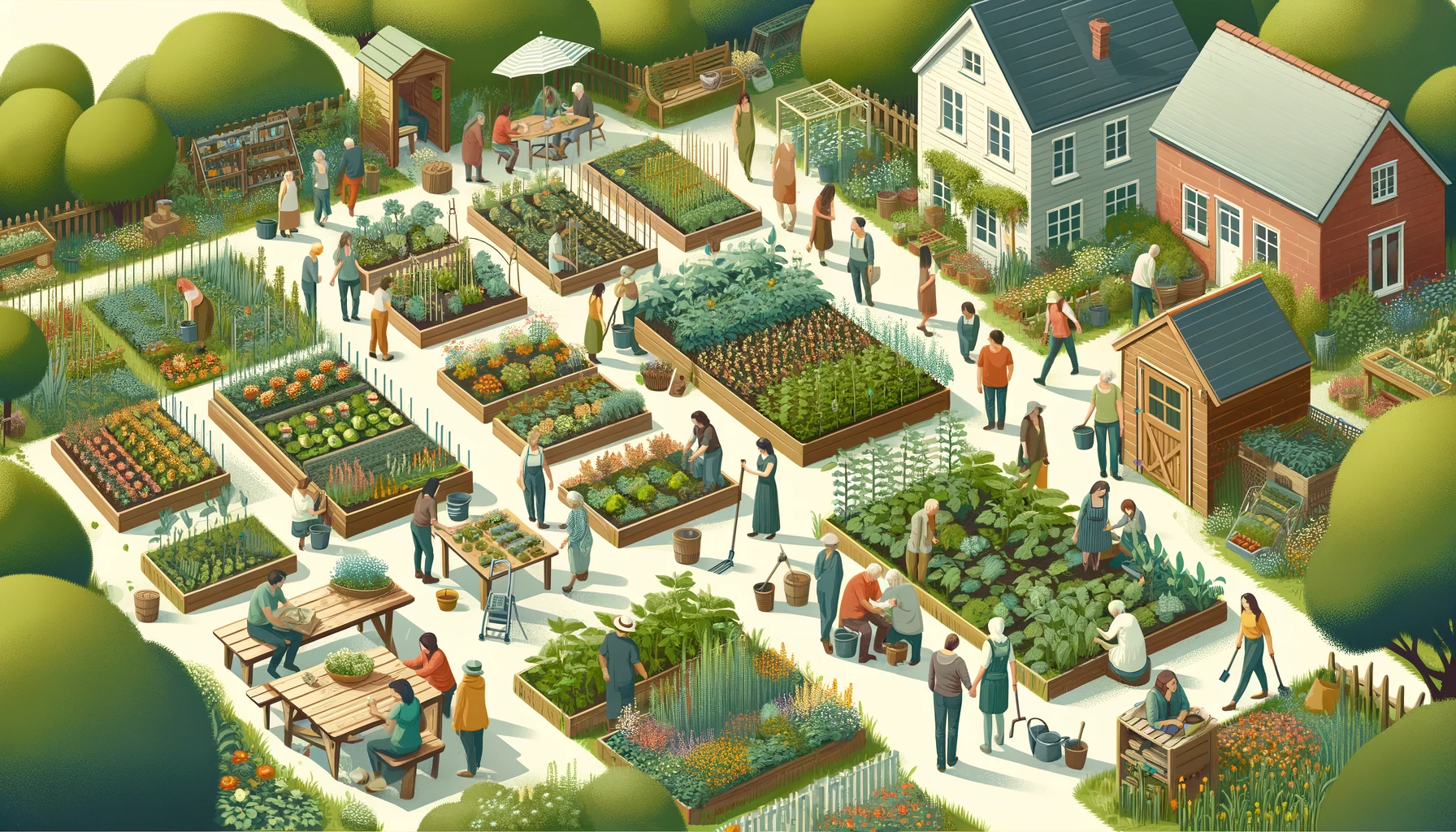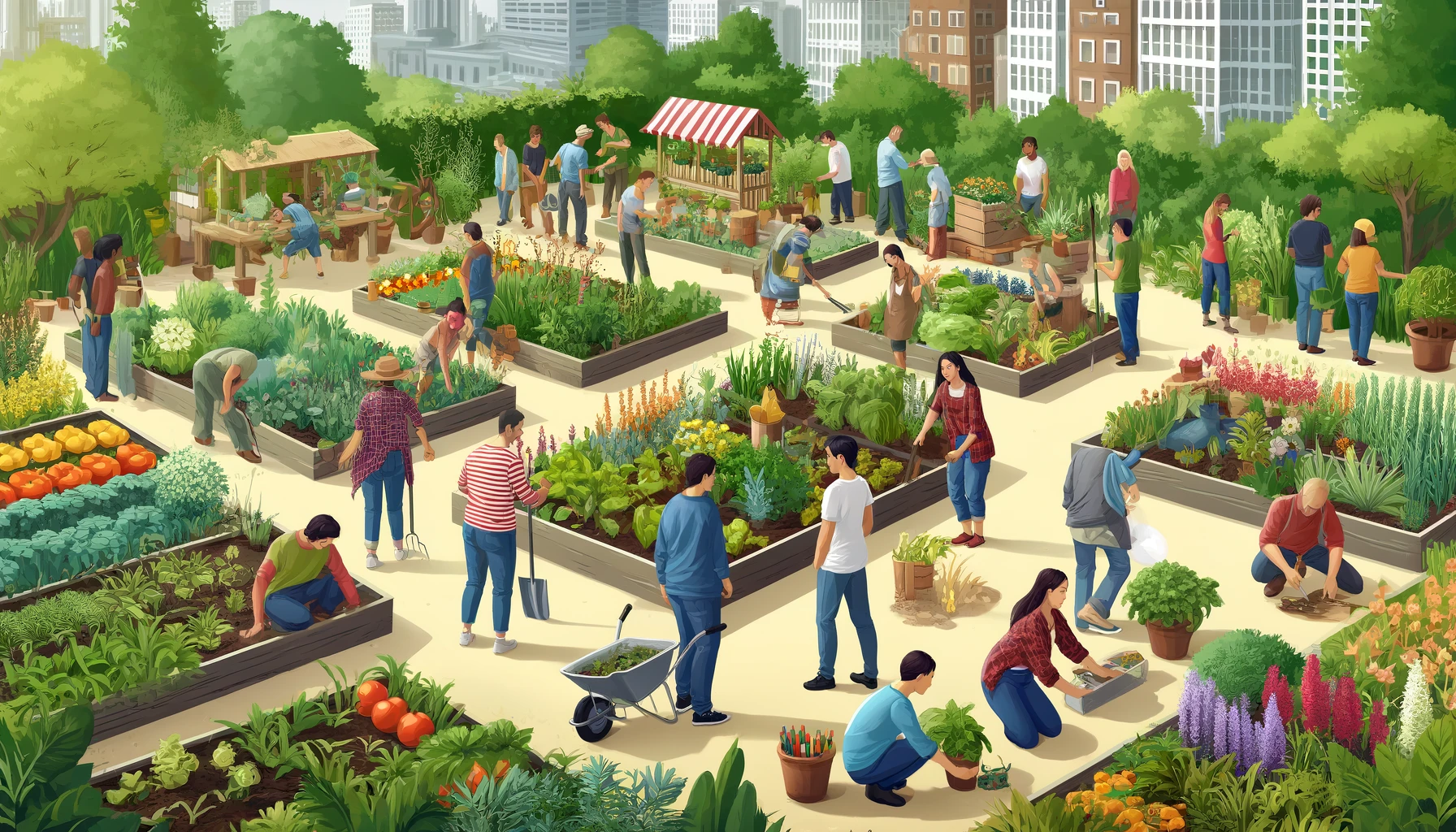We use affiliate links. If you purchase something using one of these links, we may receive compensation or commission.
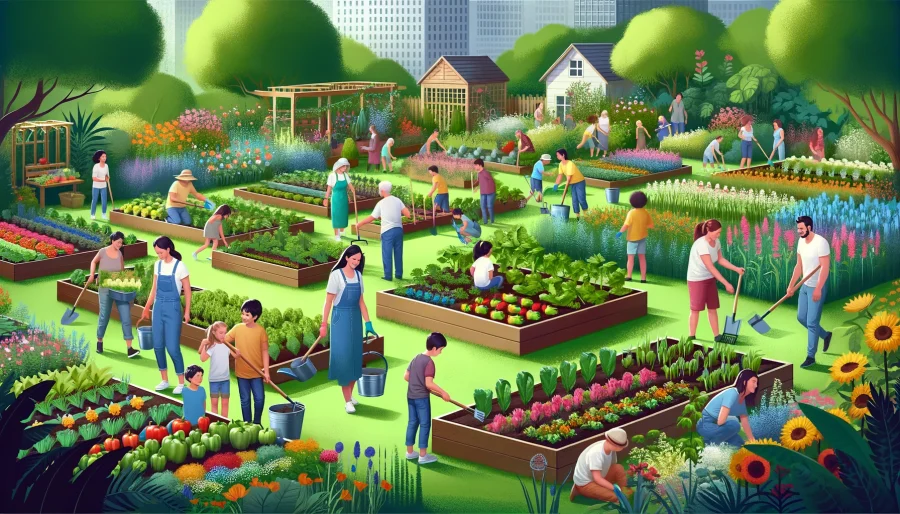
Community Garden Health Benefits are more than just fresh veggies and pretty flowers. They boost your health in ways you might not expect. Ready to learn how?
Community Garden Health Benefits Key Takeaways
- Health Benefits of Community Gardening include:
- Increased physical activity, better nutrition, stress relief, and stronger community bonds.
- Gardening helps you stay active, eat fresh, reduce stress, and connect with neighbors, making it a win-win for everyone.
Community Garden Health Benefits
Community gardens aren’t just about growing plants; they’re about growing health and happiness.
With their rising popularity, these gardens offer a range of benefits that boost individual well-being and strengthen communities.
Let’s explore how community gardens can improve your life.
What Are Community Gardens?
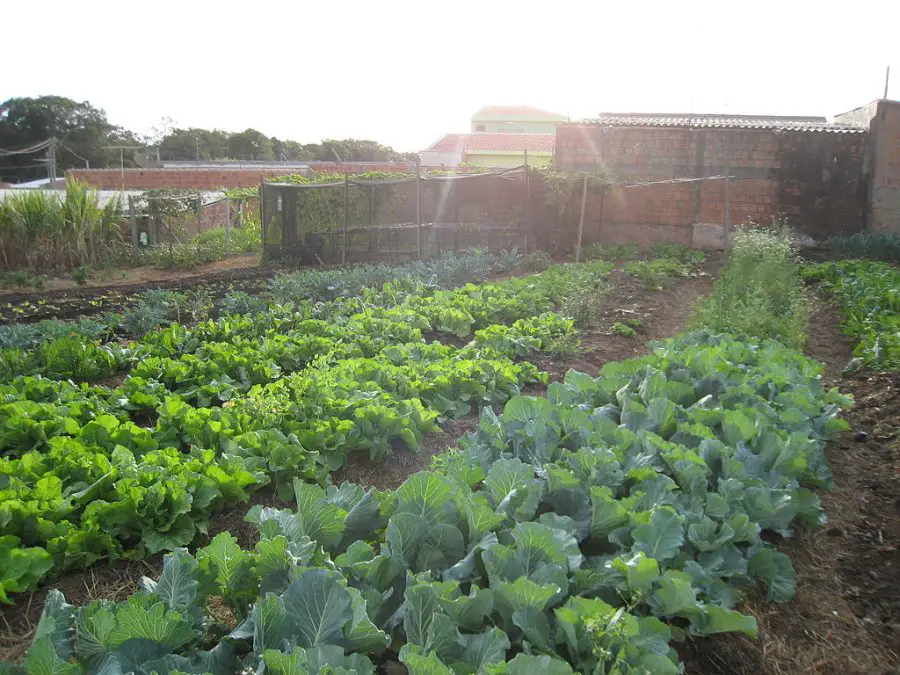
Community gardens are shared spaces where individuals come together to grow plants, vegetables, and flowers.
These gardens are typically located in urban areas, providing a green oasis for city dwellers.
They serve as a hub for community interaction, education, and sustainable living.
Definition and Basic Concept
Community gardens are plots of land collectively managed and maintained by a group of people.
They can be found in vacant lots, schoolyards, or even rooftops.
The primary goal is to grow food and plants, but they also focus on fostering a sense of community and environmental stewardship.
Community Involvement and Shared Spaces
In a community garden, everyone has a role. Members share responsibilities like planting, watering, and harvesting.
These gardens often host community events, workshops, and educational programs to teach gardening skills and promote healthy living.
Examples of Typical Community Garden Setups
Community gardens vary widely in their setups.
Some have individual plots assigned to each gardener, while others use communal plots where everyone contributes to and benefits from the harvest.
Common features include raised beds, composting areas, tool sheds, and spaces for social gatherings.
For instance, gardens in city parks might include fruit trees, vegetable beds, and flower patches.
The Rise in Popularity
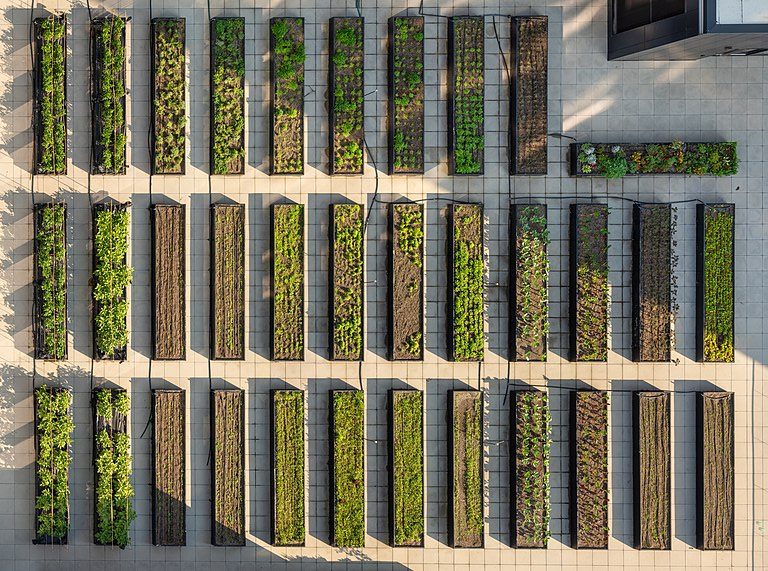
Community gardens have seen a surge in popularity over the past decade.As people seek out more sustainable and healthy lifestyles, these gardens have become a favorite in urban areas.
Let’s explore the recent trends, the growth in urban gardening, and the support from various community initiatives.
Recent Trends and Statistics
In recent years, community gardens have blossomed across cities worldwide.
Statistics show a significant increase in the number of community gardens, reflecting a growing interest in local food production and sustainable living.
Many urban centers now boast numerous community gardens, each serving as a testament to the growing demand for green spaces and fresh produce.
Growth of Community Gardens
| Year | Number of Community Gardens | Percentage Increase |
|---|---|---|
| 2012 | 16,240 | – |
| 2018 | 29,000 | 44% |
| 2023 | 44,000 | 51.7% |
Additional Insights
- Urban Growth: Urban gardening has seen a significant rise, particularly among millennials who are keen on promoting sustainability and green spaces in cities.
- Food Security: Community gardens can lower household food security concerns by up to 90%, providing fresh produce and improving nutrition.
- Physical and Mental Health: Community gardeners eat 37.5% more fruits and vegetables than non-gardeners and experience better overall health outcomes.
These statistics illustrate the increasing importance and popularity of community gardens, highlighting their role in promoting health, sustainability, and community cohesion.
Increased Urban Gardening
Urban gardening has become a key part of city life. With more people living in apartments and condos, the need for shared gardening spaces has skyrocketed.
Community gardens provide a solution, offering a place for city dwellers to connect with nature and grow their own food.
The rise of rooftop gardens, balcony gardens, and even small indoor setups highlights the creative ways people are incorporating gardening into urban living.
Community Initiatives and Support
The growth of community gardens has been bolstered by various community initiatives and support programs.
Local governments, non-profits, and grassroots organizations have played a crucial role in establishing and maintaining these gardens.
They offer resources such as funding, tools, and educational workshops to help communities start and sustain their gardens.
This support has been instrumental in making community gardening accessible to a wider audience, ensuring that everyone, regardless of background, can enjoy the benefits of gardening.
Physical Health Benefits
Community gardens offer a fantastic way to boost physical health. Let’s dig into how they can help you stay fit and healthy.
Increased Physical Activity
Gardening involves a lot of movement. Tasks like digging, planting, weeding, and watering require physical effort, making it a great workout.
Spending time in the garden helps improve strength, flexibility, and stamina.
Plus, it’s a fun way to stay active without feeling like you’re exercising.
Better Nutrition and Access to Fresh Produce
One of the biggest perks of community gardening is the fresh, nutritious produce.
Growing your own fruits and vegetables means you have easy access to healthy food.
This can lead to a better diet rich in vitamins and minerals, essential for overall health.
Fresh produce from the garden often tastes better and is more nutrient-dense than store-bought options.
Weight Management and Improved Fitness
Regular gardening activities help burn calories, contributing to weight management.
Being physically active in the garden helps maintain a healthy weight and improves fitness levels.
It’s a great way to combine exercise with the joy of growing your own food, making weight management more enjoyable and sustainable.
Community gardens offer a holistic approach to physical health, combining physical activity with better nutrition and fitness. It’s a win-win for your body and mind!
Mental Health Benefits
Community gardens are not just good for the body; they work wonders for the mind too. Here’s how they help with mental health.
Stress Relief and Relaxation
Gardening is a soothing activity. The repetitive tasks and connection with nature can reduce stress and promote relaxation.
Being outdoors, feeling the soil, and watching plants grow can provide a sense of peace and tranquility.
It’s like a natural therapy session, right in your backyard.
Enhanced Mood and Mental Well-Being
Spending time in a community garden can significantly boost your mood.
The act of nurturing plants and seeing them thrive can create a sense of accomplishment and joy.
Fresh air, sunlight, and physical activity all contribute to releasing endorphins, the body’s natural mood lifters.
Gardening can help combat anxiety and depression, making you feel happier and more content.
Social Support and Community Bonding
Community gardens are social hubs. They bring people together, fostering a sense of belonging and camaraderie.
Working alongside neighbors, sharing tips, and enjoying the fruits of your labor together builds strong social ties.
This support network can be crucial for mental well-being, providing friendship, encouragement, and a shared sense of purpose.
In essence, community gardens offer a sanctuary for both the mind and spirit, promoting relaxation, happiness, and social connections.
Social Benefits
Community gardens do more than grow plants; they grow communities.
Here’s how they bring people together and make neighborhoods safer and more connected.
Building Stronger Community Ties
Community gardens are fantastic for fostering stronger relationships among neighbors.
They provide a common space where people can meet, work together, and share their gardening experiences.
This shared activity helps build trust and camaraderie, creating a close-knit community.
It’s a great way to get to know your neighbors and build lasting friendships.
Reducing Crime and Promoting Safety
Interestingly, community gardens can help reduce crime rates in neighborhoods.
By transforming vacant lots into vibrant green spaces, they make areas more attractive and less likely to be targets for criminal activity.
A well-maintained garden signals that the community is active and cares about their neighborhood, which can deter crime and promote safety.
Additionally, increased foot traffic and community presence in garden areas can make people feel safer.
Inter-generational Interaction and Learning
Community gardens are excellent venues for inter-generational interaction.
They bring together people of all ages, from young children to seniors.
This interaction allows for the exchange of knowledge and skills, with older gardeners sharing their experience and younger ones bringing new energy and ideas.
It’s a valuable learning environment where everyone benefits from the collective wisdom and enthusiasm of the group.
Community gardens are powerful tools for building stronger, safer, and more connected communities, enriching lives through shared experiences and collective effort.
Educational Opportunities
Community gardens are rich with learning opportunities. They provide hands-on education that benefits individuals and the community alike. Let’s explore the educational perks they offer.
Learning About Sustainable Practices
Community gardens are excellent places to learn about sustainability. Participants can:
- Explore eco-friendly practices like composting and rainwater harvesting.
- Learn organic gardening techniques.
- Gain hands-on experience in methods that minimize environmental impact.
These gardens teach how to grow food in a way that supports the health of the planet, promoting environmental awareness and stewardship.
Skill-Building in Gardening and Teamwork
Gardening itself is a skill that takes time and practice to develop. In community gardens, participants can:
- Learn the basics of planting, watering, and maintaining a garden.
- Refine techniques and experiment with new methods.
- Develop teamwork skills by collaborating, sharing resources, and supporting each other’s efforts.
This fosters a spirit of cooperation and mutual aid, benefiting everyone involved.
Workshops and Community Events
Many community gardens host workshops and events to educate and engage the community. These might include:
- Classes on topics like organic gardening, pest management, and crop rotation.
- Seasonal events such as harvest festivals or planting days.
These gatherings not only provide valuable knowledge but also strengthen community bonds by bringing people together for a common purpose.
Community gardens are dynamic learning environments.
People can gain practical skills, deepen their understanding of sustainability, and enjoy a sense of community through shared educational experiences.
Environmental Benefits
Community gardens are more than just green spaces; they provide significant environmental benefits. Here’s how they make a difference:
Urban Greening and Biodiversity
Community gardens transform vacant lots into lush, green spaces. This urban greening:
- Enhances the aesthetic appeal of neighborhoods.
- Provides habitats for various plants, insects, and wildlife.
- Increases biodiversity in urban areas.
Sustainable Practices Like Composting
Community gardens often adopt sustainable practices. Key practices include:
- Composting organic waste to enrich the soil naturally.
- Using rainwater harvesting systems to conserve water.
- Avoiding chemical pesticides and fertilizers, promotes healthier ecosystems.
Reducing Carbon Footprints
By growing food locally, community gardens help reduce carbon footprints. Benefits include:
- Decreasing the need for long-distance food transportation.
- Cutting down on greenhouse gas emissions.
- Promoting local food production, which is more environmentally friendly.
Community gardens contribute to a healthier environment through urban greening, sustainable practices, and reducing carbon footprints.
Economic Benefits
Community gardens not only foster health and community spirit but also offer economic advantages. Here’s how they contribute economically:
Improving Food Security in Low-Income Areas
Community gardens are crucial for enhancing food security. They:
- Provide fresh produce to families who may struggle to afford it.
- Reduce dependency on food banks and other food aid programs.
- Ensure access to nutritious food, improving overall health and reducing healthcare costs.
Creating Economic Opportunities Through Local Markets
Community gardens create opportunities for local economies by:
- Allowing gardeners to sell excess produce at local farmers’ markets.
- Supporting local businesses that provide gardening supplies and tools.
- Creating jobs related to garden maintenance, education, and management.
Reducing Household Food Expenses
By growing their own food, families can significantly cut down on grocery bills. Benefits include:
- Saving money on fresh fruits and vegetables.
- Reducing transportation costs by sourcing food locally.
- Encouraging self-sufficiency and reducing reliance on commercial food sources.
Community gardens play a vital role in boosting local economies, improving food security, and reducing household expenses, making them valuable assets to any community.
Addressing Challenges
Community gardening is rewarding, but it comes with its own set of challenges.
Here’s a look at common issues and how to overcome them, along with some success stories.
Common Issues in Community Gardening
Community gardens often face several challenges, including:
- Soil Contamination: Urban soils can be contaminated with heavy metals or pollutants.
- Funding and Resources: Securing funding for tools, seeds, and maintenance can be difficult.
- Volunteer Management: Consistent volunteer participation is crucial but can be hard to maintain.
- Land Access: Finding and securing land for gardening can be challenging, especially in urban areas.
Practical Solutions and Best Practices
To tackle these issues, consider the following solutions:
- Soil Testing and Remediation: Regularly test soil and use raised beds with clean soil if contamination is found.
- Fundraising and Grants: Apply for grants, host community events, and partner with local businesses for sponsorship.
- Volunteer Engagement: Create a welcoming environment, offer flexible schedules, and recognize volunteer contributions to keep engagement high.
- Community Partnerships: Work with local governments, schools, and organizations to secure land and resources for the garden.
Success Stories and Community Impact
Successful community gardens have made a significant impact:
- Detroit’s Urban Gardens: Many vacant lots have been transformed into thriving gardens, providing fresh produce and fostering community pride. Read more
- New York City’s GreenThumb Program: This program supports over 550 community gardens, helping to revitalize neighborhoods and improve residents’ quality of life. Read more
- Los Angeles Community Garden Council: This organization helps establish and sustain gardens across the city, promoting food security and environmental stewardship. Read more
By addressing common challenges with practical solutions and drawing inspiration from successful projects, community gardens can thrive and make a positive impact on their communities.
Health Benefits of Community Gardening FAQs
Community gardens are gaining popularity due to their numerous benefits.
Below are some frequently asked questions about community gardens and their health benefits.
Q: What is a community garden?
A: A community garden is a shared space where people come together to grow plants, vegetables, and flowers. These gardens can be found in urban, suburban, or rural areas and are managed collectively by the community members.
Q: Why are community gardens important?
A: Community gardens play a vital role in providing fresh, nutritious food, fostering community ties, promoting physical and mental well-being, and creating green spaces that improve environmental quality.
Q: How do community gardens improve physical health?
A: Gardening involves physical activities such as digging, planting, and weeding, which can increase strength, flexibility, and stamina. Access to fresh produce also promotes better nutrition.
Q: What mental health benefits do community gardens offer?
A: Gardening can reduce stress, enhance mood, and provide a sense of accomplishment. Being part of a community garden also helps reduce feelings of isolation by fostering social connections.
Q: How do community gardens benefit the environment?
A: Community gardens help improve urban green spaces, support biodiversity, and encourage sustainable practices like composting. They also reduce carbon footprints by promoting local food production.
Q: Can anyone join a community garden?
A: Yes, most community gardens are open to anyone interested in participating. Membership details and participation requirements can vary, so it’s best to check with your local community garden for specific information.
Q: What challenges do community gardens face?
A: Common challenges include soil contamination, securing funding and resources, maintaining volunteer participation, and accessing land. Solutions involve soil testing, fundraising, community partnerships, and volunteer engagement strategies.
Q: How can I get involved in a community garden?
A: You can join a local community garden by attending meetings, volunteering, participating in workshops, and possibly renting a garden plot. Many gardens also welcome donations and support from community members.
Q: Are there any economic benefits to community gardens?
A: Yes, community gardens can improve food security, reduce household food expenses, and create economic opportunities through local markets and job creation.
By addressing these common questions, we hope to highlight the numerous benefits of community gardens and encourage more people to get involved in their local green spaces.
If you have more questions or want to learn how to start your own community garden, feel free to reach out to local gardening organizations or community centers.
Community Garden Health Benefits Conclusion
Community gardens offer a wealth of benefits that extend far beyond just growing plants.
They enhance physical and mental health, foster strong social connections, and promote environmental sustainability.
Here’s a summary of the multifaceted benefits of community gardens and why you should consider getting involved.
Summary of Benefits
Community gardens provide numerous advantages that can improve your quality of life and strengthen your community.
- Physical Health: Increased physical activity, better nutrition, and weight management.
- Mental Health: Stress relief, enhanced mood, and social support.
- Social Benefits: Stronger community ties, reduced crime, and inter-generational learning.
- Educational Opportunities: Learning sustainable practices, skill-building, and community events.
- Environmental Benefits: Urban greening, biodiversity, and reduced carbon footprints.
- Economic Benefits: Improved food security, economic opportunities, and reduced household expenses.
Get Involved
Getting involved in a community garden is a great way to reap these benefits.
Whether you join an existing garden or start your own, you’ll be contributing to a healthier, more connected, and sustainable community.
Key Takeaways
- Physical Health: Boost your fitness and enjoy fresh produce.
- Mental Health: Reduce stress and connect with others.
- Social Benefits: Build stronger community bonds.
- Environmental Impact: Support urban green spaces and sustainability.
- Economic Advantages: Save money and improve food security.
Community gardens are powerful tools for improving health, building community, and protecting the environment.
Dive into the world of community gardening and experience these benefits for yourself!
Learn more: Community Gardens Benefits: How To Start a Community Garden
Resources for Community Garden Health Benefits
If you’re interested in diving deeper into the health benefits of community gardens, here are some authoritative articles that provide valuable insights and research findings.
- Community Gardens and Their Effects on Diet, Health, Psychosocial, and Community Outcomes
This article from BMC Public Health provides a comprehensive review of the impacts of community gardening on diet, health, and community well-being. It summarizes numerous studies that highlight the benefits of community gardens in various contexts.
Read more here - The Impact of Gardening on Well-Being, Mental Health, and Quality of Life
Published in the Systematic Reviews journal, this meta-analysis explores the positive effects of gardening on mental health and overall well-being, emphasizing the psychosocial benefits of community gardening activities.
Read more here - Evidence on the Contribution of Community Gardens to Promote Physical and Mental Health and Well-Being
This PLOS ONE article discusses how community gardens can improve physical and mental health, particularly in urban settings. It highlights the role of green spaces in enhancing the quality of life for city dwellers.
Read more here - Public Health Benefits of Community Gardens
Tulane University’s School of Public Health outlines the multiple public health benefits of community gardens, including increased fruit and vegetable intake, community beautification, and educational opportunities.
Read more here - Amplifying Health Through Community Gardens: A Framework for Understanding the Relationship
This Springer article provides a framework for understanding how community garden participation leads to various health impacts, including improved diet and chronic disease outcomes.
Read more here
By exploring these resources, you can gain a deeper understanding of the significant health benefits that community gardens offer and find inspiration to get involved in or start your own community garden.

